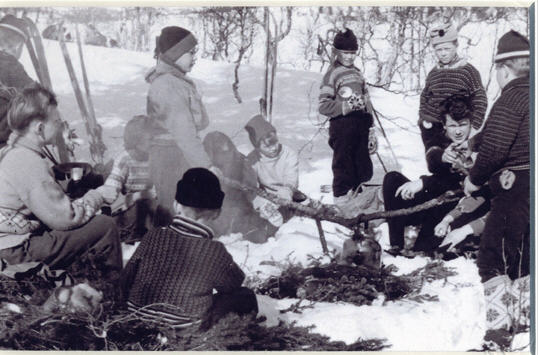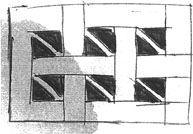 Åarjelh-saemien gielesne
Åarjelh-saemien gielesne  Davvisámegillii
Davvisámegillii
 På norsk
På norsk
 Åarjelh-saemien gielesne
Åarjelh-saemien gielesne  Davvisámegillii
Davvisámegillii
 På norsk
På norsk
Article in the book Sami School History 1. Davvi Girji 2005.
 Albert Jåma, Trones in Namdalen, 2003. |
Albert Jåma was born in 1946 and has grown up in a reindeer herding family. In winter they stayed in areas near to the coast in Namdalen, and in summer in the higher mountain areas in the northern part of Nord-Trøndelag. Today he himself is a reindeer herder in this area. Here he tells about his school days and about his life between school and reindeer herding. |
Albert's father, Anselm Jåma, was actively involved in South-Sami school affairs. He was for many years leader of the South-Samis' school commitee. For his hard work for Sami school and other Sami affairs, he was granted the King's Gold Medal in 1968. The school commitee was established in 1902, but was liquidated in 1947, as the authorities promised that there would be built a state owned dormitory school for South-Samis. But as the provisional school which in 1951 was started in Hattfjelldal was not what the South-Samis had been fighting for, the commitee was reorganised in 1953. It was mainly the Samis in Trøndelag and Hedmark who took part in this commitee. Most Samis in Hattfjelldal and Vefsn were afraid that founding of a new Sami school in Trøndelag would mean losing the offer they now had in Hattfjelldal. [1] It was quite a long time before the work of the school commitee showed any visible results. The Sami school in Snåsa was finally started in 1968.
Albert's 4 years older brother spent his first school years in the old Sami mission school in Havika. Albert himself got his whole primary schooling at the Sami school in Hattfjelldal 1953-60. He joined the school in the third year of its life.
- It was a quite provisional school which met us in Hattfjelldal. It was build by the Germans during 2. World War as a barrack for officers. After the war the building was used as a hotel. The school hired the building for the school year, but it was run as a hotel in summer. The owner of the hotel lived at the school and looked after his hotel equipment the first three-four years.
However, for all the time when I was at the Sami school, there had been a housekeeper who could speak Sami. First it was Maja Staven (Lifjell) until we were in the 4th class, after that Sofie Kappfjell. There were also some others working in the dormitory who talked Sami, among others Skjolvor Joma. Åsta Larsen also worked there for a short time.
Most pupils came from reindeer herding families, and the school year was adapted to the herding seasons. That was important so that we should not lose contact with our roots. The first years we went to school only before Christmas, about 16 weeks with 6 days a week. The higher classes went to school in spring, about 22 weeks. That way we had less hours than the village school in Hattfjelldal, and I remember that the village children envied us having so much free time.
In spite of the lack of Sami language and content, Albert's memories of school are overwhelmingly positive:
- The school gave us a feeling of common interests. We had to take responsibility for each other and develop solidarity.
Also as regards environment and learning it was a good school. Sometimes there were quizes between the schools in Hattfjelldal, and the Sami school used to be the winner.
My mother was a member of the school's supervision council, as the only woman. It can't have been easy at that time, because the council was dominated by men with social status, like the parish priest and the local doctor. They did not always accept that a woman without higher education or noble pedigree having her own voice.

| Skiing day with campfire approx. 1960, Albert Jåma to the left.
(Photo: Grete Austad) |
In 1968 the State Reindeer Herding School was established at Borkenes near Harstad, and Albert was accepted as a pupil. He should of course have started in autumn together with the others, but there was so much to do in reindeer herding that he did not get away.
- I got a dispensation to stay at home the whole autumn, and I was in the mountains all the time. Then I went to school in January with strict orders to work hard go catch up with the others. The only subjects which were new to me, were geology, soil knowledge and domestic animals knowledge. It was about cultivation of grass and rearing cows, typical agricultural school subjects. But these subjects were not very much stressed. Bookkeeping was a new subject for most pupils, but I had fortunately learnt it in the "realskole", so I had no problems in catching up with the others. The other subjects I was mostly acquainted with.
There were almost only boys in the class, only one girl. The pupils came both from South-Sami areas and from Troms and Finnmark. The North- and South-Samis got on well together. This contact was always in Norwegian, as we did not understand each other's Sami language. The North-Sami pupils spoke Norwegian well. I only remember one who perhaps had a little problems with the Norwegian language.
- The Reindeer Herding School was in a Norwegian agricultural village and had to defer to a gardening school. This probably had to lead to some cultural collision.
- There had been some problems in autumn, before I came, both at school and in the village. In the reindeer herding school there were mainly older pupils, as there had not been such an offer before. Yes, we had some parties, and the headmaster, who actually was the headmaster of the gardening school, got a little scared by us. The chairman of the board of the Reindeer Herding School, Anders Oskal, had to come to the school to mediate. But we were popular among the girls in the village. They were certainly not afraid of us. To me it was an interesting village environment.
- To start a reindeer herding school from nothing can't have been easy. Did you have any schoolbooks?
- The main book was " Rein og reindrift" (Reindeers and reindeer herding) by Sven Skjenneberg, who was a researcher at Statens reinforsøk (State reindeer research station) in Lødingen. To get the Reindeer Herding School accepted by the Ministry of Agriculture, we had to have agricultural subjects. So a certain percent of the plan consisted of such subjects. But we succeeded in exchanging some of the subjects, for example replacing tractor studies with snow scooter studies. The school bought an old Varg on which we trained mechanical skills and a new Ockelbo on which we tore around.
- I had to be in the mountains. My brother married early and moved out, and I was left alone with my parents. After some years my family got more help. It was the Anti brothers who came from Karasjok and started working with reindeers together with my family. Then after some time I got time to get away for more schooling, and I took one year gymnasium (upper secondary school) at Oslo språkskole (language school). After that I applied to journalist college. I saw the need to spotlight all the injustice which the Samis had to bear. But unfortunately I was not admitted. I had choosen teachers' college in Alta as a good number two, and I got in there instead. Again I got permission to start after the others. The slaughtering had of course to be finished first. It was two years with a lot of leave of absence, because I all the time had to go home for reindeer collection and slaughtering. At that time there was already a Sami department in Alta College, but this was only for students who spoke North-Sami. I had to attend the department of ordinary Norwegian students, and I did not get any professional Sami content during my teachers' education. While I was i Alta I took an introduction course in North-Sami in my leisure time, with Håkon Henriksen as a teacher. My final year of study was in Trondheim, to be nearer home.
After teachers' college he went back to reindeer herding for some years, before he started as a teacher in Snåsa.
- I really did not have time to work as a teacher, but after some pressure I took some years at the Sami school in Snåsa. They then had some pupils with Sami as their first language, but the first language teacher had left. At the same time as I was working as a teacher I was responsible for the reindeer herding unit. Therefore I was dependent on having an agreement with the school administration so that I could attend reindeer herding when necessary
- You say that you have been teaching South-Sami language, but you did not yourself learn it at school. When did you learn to read and write your own mother tongue?
- In the schools which I attended there was South-Sami teaching. As an adult I joined a couple of courses at Snåsa, which the headmaster of the Sami school Ella Holm Bull was in charge of. Later I took a half year unit in South-Sami at Snåsa arranged by Levanger College, and several years later the other half year unit in Hattfjelldal. It was organised by Nesna College.
 
| (Drawing: Josef Halse)
|
[1]
More articles from Sami School History 1
[2]
[3]